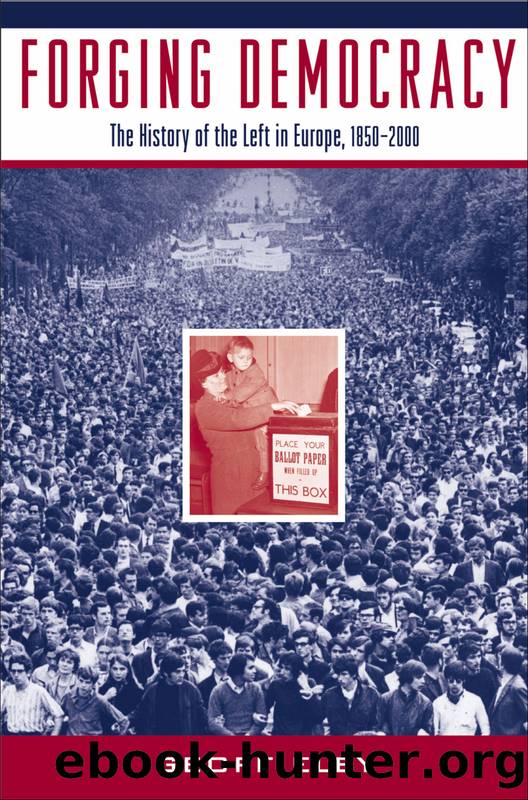Forging Democracy by Eley Geoff;

Author:Eley, Geoff;
Language: eng
Format: epub
Publisher: Oxford University Press
Published: 2002-07-14T16:00:00+00:00
These people are not Socialists. They are not even respectable Marxists. They are a new brand of anarchists, very different from the endearing characters whom many of us knew. … They are wreckers who … are concerned only to disrupt society. Their weapons are lies, misrepresentations, defamation, character assassination, intimidation and, more recently, physical violence.50
This “generation gap” was embraced on both sides: “The best poster on the walls of my faculty, I remember it really distinctly, out of all the posters there: ‘I want to be an orphan.’”51
Students multiplied in the 1960s—trebling in France, Greece, and Scandinavia, doubling in Italy, the Low Countries, West Germany, Britain, and Iberia.52 Spectacular unrest affected Italy, West Germany, and France, countries where university entrance required only completing academic high school rather than selection. The baby boom contributed—with birthrates 30 percent higher for 1946–50 than 1935–39 in Britain and France and West German and Italian increases following later. School leaving age was also raised, and youth straddled childhood dependence and adult “responsibility,” creating a new category of young people with time, knowledge, money, and growing self-consciousness, targeted as a market and concentrated in distinctive institutions but juridically excluded from citizenship.
Student radicalism reached beyond the university to a broader rebelliousness of youth. If Paris saw the synergy of students and workers, London had the counterculture. Entrepreneurial freebooting and creative experimentation exploded across publishing, music, design, theater, and performance in London, with new careers in media, arts, and entertainment. In 1966–68, the British “Underground” was a kaleidoscope of institutions, including the Notting Hill Free School, the Anti-University, Indica Gallery, the Arts Lab, Apple, the Electric Cinema, the Macrobiotic Restaurant, a series of clubs, and a mosaic of “happenings” and festivals. One climax, marked by the drug prosecutions of John Hopkins, a leading counterculture impresario, and the Rolling Stones, was the Fourteen Hour Technicolor Dream at the Alexandra Palace and the release of the Beatles’ Sergeant Pepper’s Lonely Hearts Club Band. This scene, imbricated with the arts and theater avant-garde, suffused with the drugs aesthetic, and luxuriating in stylistic rebellion, drew provincial talents like a magnet.53
In Britain’s New Left, ideas had coalesced around the Campaign for Nuclear Disarmament (CND) formed in 1958, linking an annual march from the Atomic Weapons Research Establishment in Aldermaston with wider agitation and a campaign in the Labour Party for unilateral nuclear disarmament. By April 1962, the four-day Aldermaston March drew 15,000 participants, with 150,000 at the final rally in Hyde Park. Key departures also occurred on CND’s left, with the Direct Action Committee (DAC) pioneering civil disobedience, increasingly against the Labour Party, which refused to outstep parliamentary channels. In October 1960, the DAC merged into the Committee of 100, organizing mass sit-downs at the Ministry of Defense (February 1961), Parliament Square (April), and Trafalgar Square (September). The state’s response hardened, with mass arrests of 826 in April, and 1,314 in September.54
The DAC anticipated key aspects of 1968—not only these forms of direct action but also appeals to workers, international solidarity with Ghana against French nuclear tests in the Sahara, and impatience at the old Left of Labour and the CP.
Download
This site does not store any files on its server. We only index and link to content provided by other sites. Please contact the content providers to delete copyright contents if any and email us, we'll remove relevant links or contents immediately.
| Anarchism | Communism & Socialism |
| Conservatism & Liberalism | Democracy |
| Fascism | Libertarianism |
| Nationalism | Radicalism |
| Utopian |
The Secret History by Donna Tartt(18865)
The Social Justice Warrior Handbook by Lisa De Pasquale(12143)
Thirteen Reasons Why by Jay Asher(8802)
This Is How You Lose Her by Junot Diaz(6804)
Weapons of Math Destruction by Cathy O'Neil(6155)
Zero to One by Peter Thiel(5694)
Beartown by Fredrik Backman(5610)
The Myth of the Strong Leader by Archie Brown(5429)
The Fire Next Time by James Baldwin(5253)
How Democracies Die by Steven Levitsky & Daniel Ziblatt(5134)
Promise Me, Dad by Joe Biden(5090)
Stone's Rules by Roger Stone(5029)
A Higher Loyalty: Truth, Lies, and Leadership by James Comey(4852)
100 Deadly Skills by Clint Emerson(4845)
Rise and Kill First by Ronen Bergman(4706)
Secrecy World by Jake Bernstein(4653)
The David Icke Guide to the Global Conspiracy (and how to end it) by David Icke(4629)
The Farm by Tom Rob Smith(4443)
The Doomsday Machine by Daniel Ellsberg(4421)
